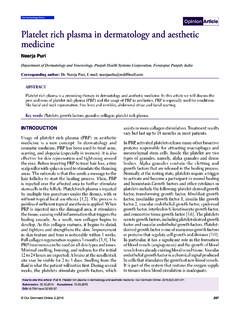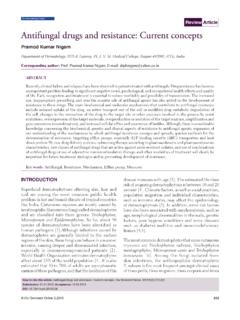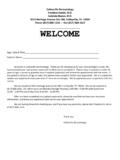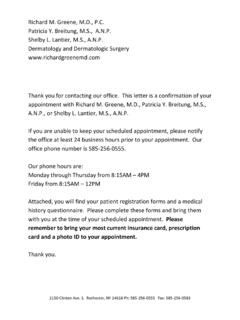Transcription of Our Dermatology Online Letter to the Editor PPincer ...
1 Our Dermatol Online 234 Our Dermatology OnlineHow to cite this article: Chang P, Argueta G. Pincer nail. Our Dermatol Online . 2016;7(2) : ; Acceptance: : nailPincer nailPatricia Chang1, G nesis Argueta21 Department of Dermatology , Hospital General de Enfermedades IGSS and Hospital ngeles, Guatemala, 2 General Doctor on Elective Dermatology Rotation, Hospital General de Enfermedades IGSS and Hospital ngeles, GuatemalaCorresponding author: Dra. Patricia Chang, E-mail: years old female with no significant past medical or family history that was seen due to contact dermatitis on her left arm, during her physical examination was observed to have onychophaty on her right toenails, pincer nails was observed on big and second toenail (Figs.)
2 1 and 2), dermatoscopic view of the pincer nails (Fig. 3). The diagnosis pincer nails was done, the patient didn t return to the another pincer nail is a dystrophy of the nail probably produced by an enlarged base of the distal phalanx, thus producing an over curvature of the nail along its long axis. It is a frequent condition on toes; other names for this condition are: incurved nails, unguis constringes, trumpet nail or omega , in toenails, the nail plate curvature is more pronounced than in fingernails, but when this curvature becomes excessive, the lateral border of the nail plate inserts itself into the soft tissue of the lateral grooves pinching the nail lateral nail plate margin sinks into the epidermis thus producing granulation tissue, as in ingrown nail [1].
3 There are three clinical types of pincer nail depending on its morphology: trumpet nail deformity (Figs. 4a - 4e), tile nail (Figs. 5a and 5b) and plicated nail (Figs. 6a - 6c) [1].Trumpet nail deformity, the most common form of pincer nail, is characterized by the nail plate lateral borders rolling under itself, taking a cylinder or omega shape, the transverse diameter of the nail is decreased and the distal border is lifted up by the traction exerted on the distal dorsal tuft, as a result the nail bed gets pinched. The plicated nail presents moderate convexity with its lateral edges sharply turned down to form a vertical sheet; then, the nails lateral edges press into the lateral nail grooves.
4 The tile nail deformity is frequently seen in tall young people, with no serious symptoms, the nail has a transverse over curvature along its longer axis and the lateral nail edges remain parallel, it forms a tile shape; this type is usually less severe [1,2].Patients with pincer nails generally have a great toe with the longer axis of its distal phalanx deviated laterally. Letter to the EditorFigure 1: Macroscopic view of pincer 2: Close up of pincer nail on second and big Our Dermatol Online 235 Overcurved nails are even more deviated in this direction. In contrary, lesser toes with pincer nails have a distal phalanx with medial deviation.
5 The overcurvated nail plate also present a distal margin lifted up [1,3].Figure 3: Dermatoscopic view of pincer 4: (a- e) Different types of pincer 5: (a and b) Tile 6: (a-c) Plicated Our Dermatol Online 236 For patients cutting this overcurved nail becomes painful and difficult; it can interfere with wearing shoes and suppose a cosmetic embarrassment. To improve cosmetic appearance, patients tend to round the distal edge of the affected nail and plate; this reduces pressure on the distal portion of the lateral nail grooves, but remains a risk of leaving a spike that will embed into the soft tissue [1].Pathogenesis of pincer nail disease is still not clear, but etiology may be divided into acquired or hereditary disorder [1,4].
6 The acquired pincer nail disorder may be due to numerous factors: ill fitting shoes or trauma producing phalanx deviation and deformity of the foot; tumors of the nail apparatus such like exostosis, implantation cyst, myxoid pseudo cyst [5]; degenerative osteoarthritis of the distal interphalangeal joints; drugs factors like beta-blocker therapy with practolol and acebutolol [6]; systemic diseases such psoriasis, the most frequent, Kawasaki s disease; the development of pincer nails deformity has been described on a women with chronic renal failure, the nail disease appeared coinciding with a severe decline in renal function [7]; pincer nail has been considered as a marker of gastrointestinal malignancy, specifically metastasing adenocarcinoma [8]; great toenail and thumb nail onychomycosis due to Trichophyton rubrum is related with pincer nail deformity; circulatory disturbance and venous hypertension due to arteriovenous fistula in the forearm may produce the pincer nail disease [1].
7 Acquired pincer nail deformity reverts after treating the base disease, discontinuation of the causal drug or correcting the causal factors [1].Hereditary pincer nail deformity is usually characterized by symmetrical changes in the nail plate and similar nail findings may be seen in other family members [9]. The condition has been described like an inherited disorder with autosomal dominant Mendelian characteristics; this condition usually affects the great toes, but the smaller toes may be also involved [1,9].The development of pincer nail deformity is related with the bone of the nail and with the base of the distal phalanx, which defines the shape of the nail plate.
8 The nail matrix is adhered to the phalanx, when the base of the distal phalanx becomes wider the proximal nail plate curvature decrease and the distal curvature increase, it produces a conical shape of the nail studies, like x rays and magnetic resonance imaging, confirm the enlargement of the phalanx, and several times it shows hook-like lateral osteophytes directed distally. There is controversy whether osteophytes are a causal factor or a result of the deformity [1,4,10,11].Pincer nails are as much of a cosmetic problem as a health problem that causes substantial discomfort and interferes with the daily life; it can cause acute pain, infections of the soft tissues, hinder the walk and impair the quality of life [10,11].
9 The indications for treatment of pincer nails dystrophy are pain and inflammation which interfere with wearing shoes or/and produce cosmetic discomfort [11].There is no consensus about subungual hyperkeratosis, as it a common finding in pincer nails but the fungal infection is rare. Some authors recommend initiating proper treatment of hyperkeratosis before treatment of the dystrophy; others, recommend pincer nail correction first and then, with the nail growing better, treatment of fungal infection with a better chance of successful treatment than on the contrary [12].There is no consensus about the most appropriate way of treatment depending on the severity of the condition, however, recurrence rates are higher with conservative treatment and it may provide only temporary relief [13].
10 Treatment of the dystrophy will depend on the patient comorbidities, preferences and expectations and the severity of the nail condition to achieve pain relief and good cosmetic methods include nail avulsion, total or partial excision of the nail bed, phenol matrixectomy of the lateral matrix horns, destruction of the matrices by electro cauterization, removal osteophytes, skin grafting or mucosal grafting of the nail bed, zig zag nail bed flap method, and others. Generally, the surgical procedures are considered an aggressive measure, to treat severe cases or for patients with deformity that is refractory to conservative approaches.









